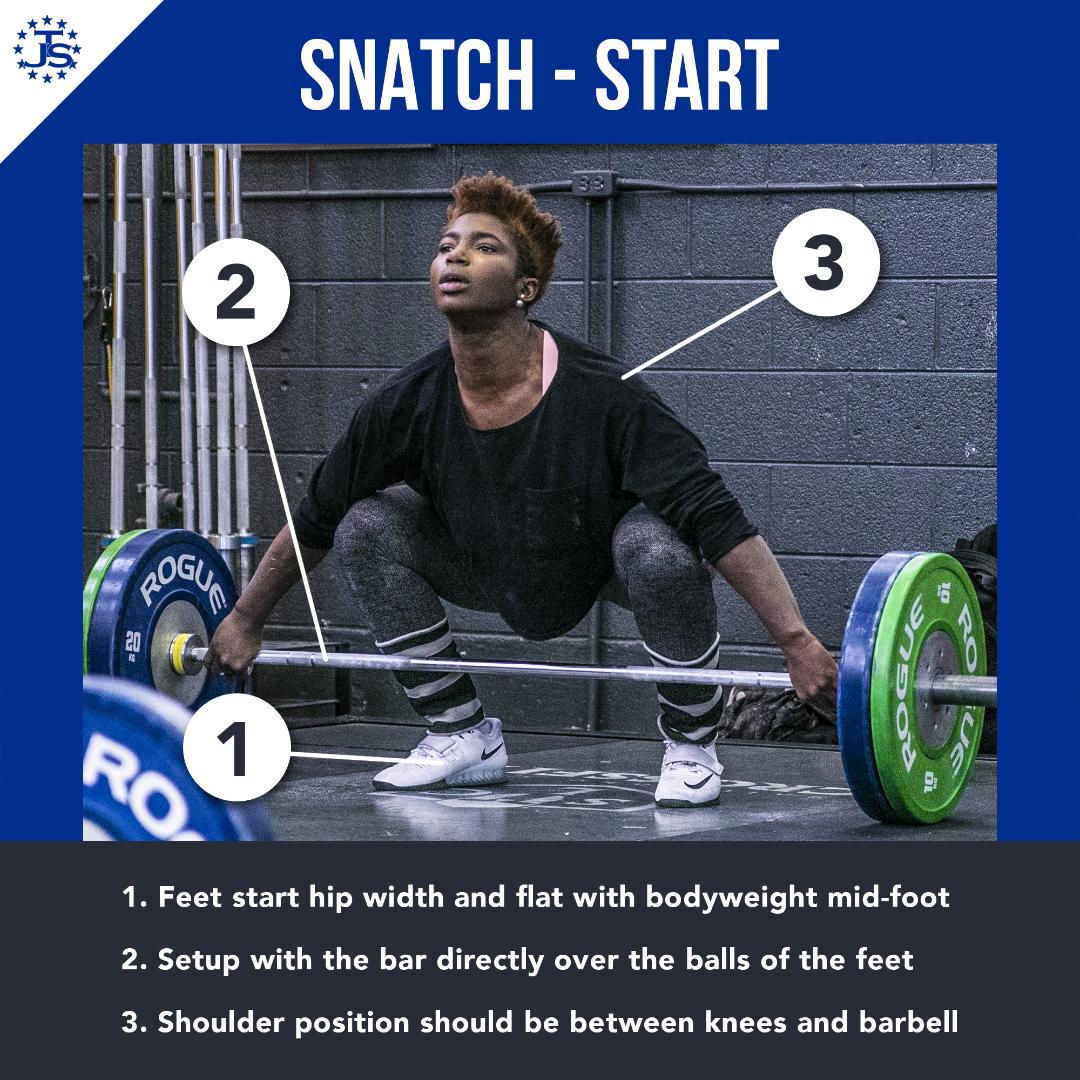Written by Chad Wesley Smith
The Snatch is one of the most complex movements in training, check out these tips to help you improve your technique.

Setting up properly in the start position is critical to success in the rest of the lift.
#1-Foot Position
By placing the feet under the hips you maximize the ability to generate an effective explosion at the top of the pull. Bodyweight should stay mid-foot during the start position to ensure balance and proper use of the legs.
#2-Bar Position
The barbell needs to start just above the balls of the feet to ensure that you can generate the proper power from the ground with your legs AND allow for the bar to travel inward towards your body as you initiate the lift.
#3-Shoulder Position
From the side view if we draw a line from the lifter’s shoulders to the ground that line should fall somewhere between the knee and the barbell and land over the ball of the foot. Lining up the position of the shoulder will automatically place the hips in the right position to start the pull.

Creating an ideal bar path in the pull is crucial to your success in the snatch. Focus on these points to ensure that the bar is traveling in the right place at the right time.
#1-Start of the Pull
Because the lifter is set up properly they are able to utilize their legs to initiate the start of the movement from the floor. This use of the legs at the start prepares you to properly position yourself for the explosion at the top of the pull by allowing you to move the knees back and distribute the forces of the pull to the low back and hips/hamstrings.
#2-Knees Moving Back
If #1 is done properly the knees should have moved back as a byproduct of the legs extending. Your shins should be approximately perpendicular to the floor when the bar is in front of the knee cap.
#3-Back Angle
If you use the legs properly from the start the back angle should remain relatively constant. Once the bar reaches the knees the shoulders should move slightly forward to compensate for the bar traveling backward as a result of the knees moving back and the bar sweeping toward you.

In order to maximize your power in the explosion you need to move properly through the transition and into the power position. Timing, position and tempo all play into this and here’s how.
#1-The Readjustment
Once the barbell has passed the knees and the legs have become fully extended your knees will readjust and shift under the barbell as a byproduct of the hips extending.
#2-The Power Position
As you continue to extend the hips your torso will move into a more vertical position as the barbell reaches your hips. Your bodyweight will remain mid-foot as the bar reaches the hip. This power position is the most advantageous position to generate an enormous power from. It is important to reach this position at the right time, rushing to get here can cause the barbell to move forward and land in front of you.
#3-The Explosion
If #1 and #2 have been successfully executed you can now maximize your explosion via a forceful and violent extension of the legs, and hips. This action should be very powerful and if executed properly will direct the barbell vertically rather than horizontally. Too much emphasis on the use of the hips rather than the legs will result in a looped trajectory.

Speed under the bar is critical to making big lifts, properly incorporating your arms into the top of the pull and the turnover can improve that speed.
#1-Active Upper Body
Your arms and upper back should actively be pulling against the bar as you squat down during the turnover. This action of pulling against the bar will keep the bar close to you and maintain a feel for where the barbel is in relation to your body.
#2-Active Feet
Lifting the feet off the platform will directly improve speed under the barbell as it allows you to move your hips downward faster.
#3-Move the Hips Down
Focusing on moving your hips down into the squat position to catch the bar will position you in the strongest and most stable place to receive the barbell. Focus on the hips will prevent you from the habit of dropping your chest to move under the bar as well.

What are the key points to remember when receiving the bar in the bottom of the overhead squat?
#1-Bar Behind Head
From the side view the bar should be positioned behind the head with the shoulders slightly internally rotated to help position the bar above the upper back.
#2-Foot Placement
Your feet should be outside your hips with the toes and knees tracking in the same plane. For some this may be more turned out for others it may be straight forward the key is that your knee and toes are tracking together.
#3-Torso Posture
The hips should be set back with the torso in a relatively vertical position and the arms locked out completely overhead. This position allows you to remain balanced over the mid foot with the barbell overhead.









